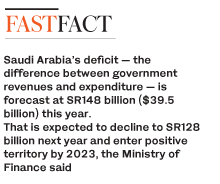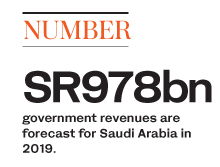RIYADH/LONDON: Saudi Arabia is on track to eliminate its budget deficit by 2023 and plans to increase spending by more than 7 percent next year.
The Kingdom’s economy was hit hard by the 2014 oil price crash, but the shortfall in its budget is expected to continue to narrow, the Ministry of Finance said on Monday.
The deficit — the difference between government revenues and spending — is predicted to be SR148 billion ($39.5 billion) in 2018. That is expected to decline to SR128 billion next year and enter positive territory by 2023, the ministry said.
The Minister of Finance, Mohammed Al-Jadaan, said he expected a “steady decline in the deficit until balancing out in 2023.”
Al-Jadaan said initiatives to develop non-oil revenues, more efficient spending, and an improvement in the targeting of subsidies had helped to narrow the deficit in the first half of 2018.
Saudi Arabia is largely dependent on oil revenues but steps are under way to diversify the economy, boost the private sector, and place a greater focus on everything from education to entertainment, and tourism to transport.
 Such measures are part of the ambitious Vision 2030 reform plans unveiled by Crown Prince Mohammed bin Salman in April 2016.
Such measures are part of the ambitious Vision 2030 reform plans unveiled by Crown Prince Mohammed bin Salman in April 2016.
Saudi Arabia’s government revenues are forecast to be SR978 billion in 2019, although public debt is expected to increase to SR678 billion, according to the data revealed in Saudi Arabia’s first-ever pre-budget statement.
Growth in gross domestic product is forecast at 2.3 percent in 2019, up from around 2.1 percent this year.
Total government expenditure is expected to hit SR1,106 billion next year, a 7.4 percent increase on this year’s forecast of SR1,030 billion.
Yaser Al-Quhaidan, deputy minister for budget and organizational affairs, said the higher spending was due to factors such as financing expenses, subsidies and social benefits.
“We are taking real steps in developing the process of preparing the general budget in line with the best global practices. This includes procedures for improving the level of governance and transparency and involving government agencies,” he said.
Saad Alshahrani, head of the finance ministry’s fiscal policy department, said the government would continue to close the budget gap through measures such as reassessing government spending and encouraging more Saudi citizens to find jobs. 
Analysts noted the improvement in the Saudi fiscal budget, but warned that the economy remained vulnerable to fluctuations in the price of oil.
“The reduction in the fiscal deficit projected for this year and next reflects sharply higher oil prices as well as increased oil production. This has allowed the government to boost spending while still reducing the budget shortfall,” Khatija Haque, head of MENA Research at Emirates NBD, told Arab News.
“However, the budget remains vulnerable to oil price volatility.”
John Sfakianakis, director of economic research at the Gulf Research Center (GRC) in Saudi Arabia, said the forecast increase in spending should encourage investments and growth in the economy.
“The fiscal picture is improving both in terms of revenues and a narrowing deficit this year as well as next given that oil revenues are on the rise,” he said.
“The fiscal map should look better in 2019 and on target for a balanced budget by 2023.”




























